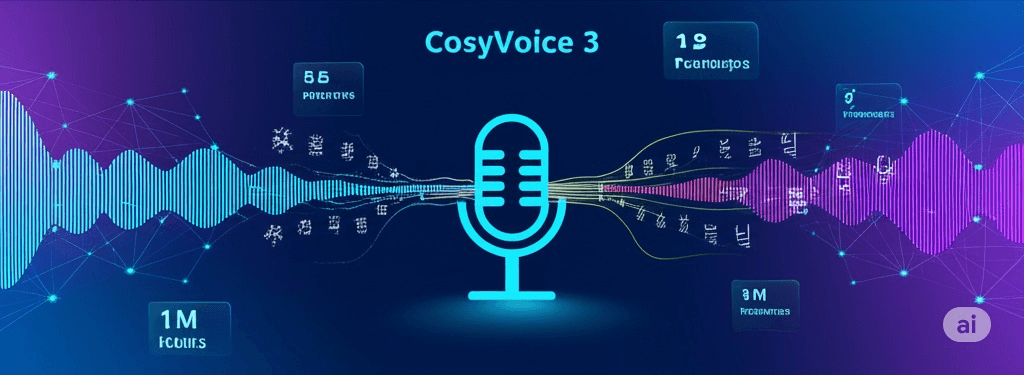CosyVoice 3: Scaling Towards In-the-Wild Speech Generation
Executive Summary
CosyVoice 3 represents a significant leap forward in zero-shot multilingual speech synthesis, designed specifically for real-world applications. Developed by Alibaba's Speech Team at Tongyi Lab, this model addresses the limitations of its predecessor CosyVoice 2 through massive scaling in both data (from 10K to 1M hours) and model parameters (from 0.5B to 1.5B), while introducing novel techniques for improved prosody naturalness and content consistency.
Key Innovations Overview
Loading diagram...
Architecture Deep Dive
1. Multi-Task Speech Tokenizer
The foundation of CosyVoice 3's improved performance lies in its novel speech tokenizer, which builds upon the MinMo multimodal LLM rather than the SenseVoice-Large ASR model used in CosyVoice 2.
Loading diagram...
FSQ Quantization Process
The Finite Scalar Quantization (FSQ) module operates through a sophisticated two-step process:
- Dimensionality Reduction: Projects intermediate representations H into a D-dimensional low-rank space
- Bounded Quantization: Quantizes each dimension into the range [-K, K] using bounded round operations
Mathematical Formulation:
H̄ = ROUND(Proj_down(H)) Ĥ = Proj_up(H̄) μᵢ = Σ(j=0 to D-1) h̄ᵢ,ⱼ × (2K + 1)ʲ
2. Differentiable Reward Optimization (DiffRO)
CosyVoice 3 introduces DiffRO, a novel post-training technique that optimizes speech tokens directly rather than synthesized audio, addressing computational challenges in traditional RL approaches.
Loading diagram...
Multi-Task Reward (MTR) Mechanism
DiffRO extends beyond basic ASR rewards to include multiple downstream tasks:
- Speech Emotion Recognition (SER): Controls emotional expression
- MOS Score Prediction: Maintains audio quality
- Audio Event Detection (AED): Handles environmental sounds
- Speaker Analysis: Preserves speaker characteristics
Training Pipeline
The CosyVoice 3 training process follows a sophisticated multi-stage approach designed to maximize performance while maintaining stability.
Loading diagram...
Stage Breakdown
- Initialization: Leverage pre-trained text-based LLMs for semantic understanding
- Large-scale Pretraining: Train on the massive 1M-hour multilingual dataset
- Post-training with DiffRO: Optimize performance using reward-based learning
- Continual Pretraining: Transfer capabilities to specialized models
- Speaker Fine-tuning: Enhance individual speaker quality and consistency
Dataset Scaling Analysis
CosyVoice 3's impressive performance stems significantly from its unprecedented dataset scale and diversity.
Loading diagram...
Chinese Dialect Coverage
Loading diagram...
Data Processing Pipeline
The multilingual data pipeline ensures high-quality training material through six critical steps:
Loading diagram...
Performance Benchmarks
SEED-TTS-Eval Results
CosyVoice 3 demonstrates substantial improvements over its predecessor and competitive models:
| Model | test-zh CER (%) | test-en WER (%) | test-hard CER (%) |
|---|---|---|---|
| CosyVoice 2 | 1.45 | 2.57 | 6.83 |
| CosyVoice 3-0.5B | 1.16 | 2.02 | 6.08 |
| CosyVoice 3-1.5B | 1.12 | 2.21 | 5.83 |
| CosyVoice 3-1.5B+RL | 0.71 | 1.45 | 5.66 |
Key Improvements:
- 44% relative improvement in Chinese content consistency
- 51% relative improvement in English content consistency
- 26% relative improvement on challenging test cases
CV3-Eval Multilingual Benchmark
CosyVoice 3 is the only system capable of handling all languages in the comprehensive CV3-Eval benchmark:
Loading diagram...
Advanced Features
1. Pronunciation Inpainting
CosyVoice 3 addresses mispronunciations through mixed word-phoneme modeling:
Loading diagram...
2. Self-Training for Text Normalization
The system eliminates hand-crafted rules through LLM-based text normalization:
Three-pronged Approach:
- Rule-based TN → Audio synthesis via CosyVoice 2
- Qwen-Max TN → Audio synthesis on normalized text
- Inverse TN → Raw text generation from existing pairs
3. Instructed Speech Generation
Extended from 1,500 to 5,000 hours of instruction-following data, supporting 100+ speaking styles:
Categories:
- Emotions: Happy, sad, angry, fearful, surprised, etc.
- Characteristics: Fast, slow, loud, soft, authoritative, etc.
- Roles: Warrior, poet, merchant, detective, etc.
- Dialects: 10 Chinese regional variants
- Accents: Indian English, Russian English, etc.
Technical Innovations Deep Dive
Model Architecture Enhancements
Diffusion Transformer (DiT) Integration
CosyVoice 3 adopts the DiT architecture for its Conditional Flow Matching (CFM) model:
Loading diagram...
Scaling Impact Analysis
The transition from 0.5B to 1.5B parameters yields measurable improvements:
Loading diagram...
Speaker Fine-tuning Innovations
Monolingual to Polyglot Transformation
CosyVoice 3 can transform monolingual speakers into polyglots through targeted training:
Loading diagram...
Capability Transfer Mechanism
The fine-tuning process preserves pre-trained capabilities while adapting to specific speakers:
- Partial Speaker ID Labeling: Mix labeled and unlabeled data
- Instruction Masking: Randomly mask speaker/style prompts
- Catastrophic Forgetting Prevention: Maintain instruction coverage
Performance Analysis & Ablations
Speech Tokenizer Comparison
Loading diagram...
DiffRO Impact Assessment
Relative improvements from DiffRO post-training:
- Korean: 68.7% WER reduction (CosyVoice 3-0.5B)
- Cross-lingual scenarios: 50%+ improvements in half of conditions
- Low-resource languages: Particularly significant gains
- Trade-off consideration: Slight speaker similarity reduction
Future Directions & Limitations
Current Limitations
- Acoustic Control: Cannot control timbre through textual instructions
- Singing Synthesis: Limited performance for singing voice generation
- Emotional Speech ASR: Evaluation challenges due to ASR model bias toward standard pronunciations
Potential Improvements
Loading diagram...
Conclusion
CosyVoice 3 represents a paradigm shift in speech synthesis, moving from controlled laboratory conditions to robust real-world applications. Through innovative multi-task tokenization, differentiable reward optimization, and unprecedented data scaling, it achieves state-of-the-art performance across multiple languages and domains.
The model's success demonstrates the importance of:
- Supervised semantic tokenization for better content-prosody balance
- Reward-based post-training for targeted performance improvements
- Massive multilingual datasets for robust generalization
- Architectural scaling combined with training innovations
For enthusiasts and researchers, CosyVoice 3 provides a comprehensive blueprint for building production-ready speech synthesis systems that can handle the complexity and diversity of real-world applications.
Demo: Listen to CosyVoice 3 samples at https://funaudiollm.github.io/cosyvoice3
Research Paper: arXiv:2505.17589v2
